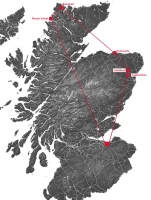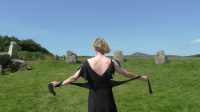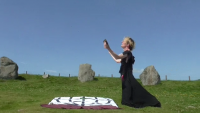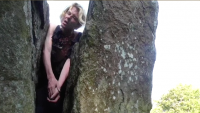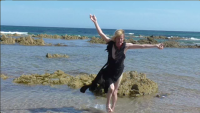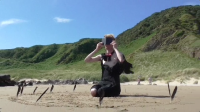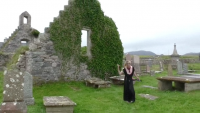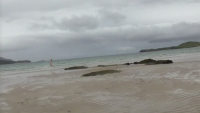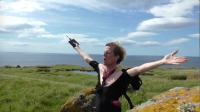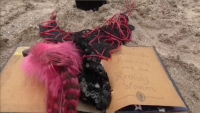Scottish Hysterics and the Keening Women Tour (2017)
This tour was a transgender pilgrimage which took place in the landscapes of my childhood in Scotland. Each of the sites was of special significance, either for their historical importance- in the case of the neolithic stone circles - or for the part they had played in my personal history. The tour started at Greyfriars kirkyard in Edinburgh, the city where my mother was born.
(1) Aquhorthies Stone circle- a short cycle from the house I grew up in, its views of the Mither Tap, highest of the Bennachie hills, inspired many a wild imagining as a teenager.
(2) Hatchery House- unofficial stopover (1)- to visit the old house where I grew up. On discovering that the hatchery, a terrible agroindustrial killing ground, had been bulldozed and that gulls were nesting in the rubble I carried out a special cleansing ritual.
(3) The Inverurie- unofficial stopover (2)- at the meeting of the rivers Don and Ury- where I dressed in a tartan miniskirt to sing the "Quine that did the strip at Inverurie".
(4) Loanhead stone circle, one of the largest in Aberdeenshire, this circle is near the town of Insch where my sister was born and site of many girl guide camps she spent several summers at. On discovering that the recumbent stone was actually split in two I squeezed in the middle to sing the litany to the rocks.
(5) Sunnyside beach, a remote beach on the north east coast and one of my mothers favourite spots. This is the place where with my brother and sister I had scattered her ashes many years ago. Before the ritual I shaved in the waters which washed them away, feeling her presence as I groomed.
(6) Balnakiel Kirkyard and beach, North West Sutherland. My family visited the craft community nearby on many summer holidays. In the ancient graveyard I sang a special keening song before crossing the road to the beach where I carried out the ritual.
(7) Handa Island, we visited this nature reserve which can only be reached via boat, as children. Puffins breed on the cliffs and skuas watched over us as we circled the island looking for a spot off the tourist trail to carry out the ritual.
The remote location of these sites of wild and untamed beauty added to the sense that this tour was a pilgrimage, a homage to nature, where I felt free to express the feminine side of my personality both with my dress and through the keening, a traditional practice which had been suppressed by the Scottish church in the 18th century as it was thought the women who carried it out were too wild and had been possessed by the devil.
The symbolism of the elements used added poignancy to these improvised keening performances:
-the necklace, containing cowrie shells I inherited from my mother who collected them from beaches around Scotland over the years and sewn with black lace and red plastic tubing by my partner and long time collaborator Anna Maria Staiano.
- the dress, worn as part of the Plañideras Culturales project
- the amulets made by Anna Maria from pink feathers (plumas in spanish, tener pluma means to be camp)
- the prayer book within the covers of a catholic litany I inscribed the text: Scottish Hysterics and the Keening Women
- and the black feathers I gleaned from a dead crow discovered in the old Kirkyard at Perth. I washed and prepared them in the sea at the Newburgh nature reserve where I birdwatched as a child.
As a homage to my parents I incorporated their names into the litany dedicated to victims of globalisation and extinct species which I had keened in previous rituals.
Through the rituals I was also recognising the important social function carried out by the women who keen for the dead not just in north west Scotland but in communities all around the world.
It may be a calling or a vocation but it is not a sentence or an imposition. It is not something we carry out because we are women or trans: it is a choice we make.
I am not ashamed to express my vulnerability, but I hope that my acts will shame others.
Esta gira fue una peregrinación transgénero que tuvo lugar en los paisajes de mi infancia en Escocia. Cada uno de los sitios fue de especial importancia, ya sea por su importancia histórica, en el caso de los menhires neolíticos, o por el papel que desempeñan en mi historia personal.
La gira comenzó en el cementerio Greyfriars de Edimburgo, la ciudad donde nació mi madre.
(1) Menhir de Aquhorthies: a un corto trayecto en bicicleta desde la casa en la que crecí, sus vistas del Mither Tap, el punto más alto de las colinas de Bennachie, inspiraron muchas fantasias paganas en mi adolescencia.
(2) Hatchery House- escala no oficial (1)- para visitar la antigua casa donde crecí. Al descubrir que el criadero, un terrible lugar de matanza de polluelos, había sido demolido y que las gaviotas anidaban entre sus escombros, llevé a cabo un ritual de limpieza especial.
(3) El Inverurie- escala no oficial (2)- en el encuentro de los ríos Don y Ury- me vestí con una minifalda de tartán para cantar el "Quine que hizo estrip en Inverurie".
(4) Menhir de Loanhead, uno de los circulos prehistoricos más grandes de Aberdeenshire, cerca de la ciudad de Insch, donde nació mi hermana y lugar de muchos campamentos en los que ella pasó varios veranos. Al descubrir que la piedra yacente en realidad estaba partida en dos, entré en medio para cantar la letanía a las rocas.
(5) Sunnyside Beach, una playa remota en la costa noreste y uno de los lugares favoritos de mi madre. Este es el lugar donde con mi hermano y mi hermana habíamos esparcido sus cenizas hace muchos años. Antes del ritual me afeité en las aguas que las llevaron, sintiendo su presencia mientras me arreglaba.
(6) Cementerio y playa de Balnakiel, noroeste de Sutherland. Mi familia visitó la comunidad artesanal cercana durante muchas vacaciones de verano. En el antiguo cementerio me sentí inspirado a cantar antes de cruzar el camino hacia la playa donde realicé el ritual.
(7) La Isla de Handa, cuando éramos niños visitamos esta reserva natural a la que sólo se puede llegar en barco. Los frailecillos atalanticos se reproducen en los acantilados y las skúas nos vigilaban mientras rodeábamos la isla buscando un lugar fuera de la ruta turística para realizar el ritual.
La ubicación remota de estos sitios de belleza salvaje e indómita se sumó a la sensación de que esta gira fue un peregrinaje, un homenaje a la naturaleza, donde me sentí libre de expresar el lado femenino de mi personalidad tanto con mi vestido como a través del keening, una práctica tradicional que había sido suprimido por la iglesia escocesa en el siglo XVIII, ya que se pensaba que las mujeres que lo llevaron a cabo eran unas salvajes que habían sido poseídas por el diablo.
El simbolismo de los elementos utilizados le agregó una emoción conmovedora a estas improvisadas presentaciones.
El collar, con conchas de cauri, herencia de mi madre, quien las recogió de playas de Escocia a lo largo de los años, ha sido cosido con encaje negro y tubo de plástico rojo por mi pareja y colaboradora desde hace mucho tiempo, Anna Maria Staiano.
- el vestido, usado como parte del proyecto Plañideras Culturales
- los amuletos hechos por Anna Maria con plumas rosas.
- el libro de oraciones. Dentro de las tapas de una letanía católica inscribí el texto: Scottish Hysterics and the Keening Women.
- y las plumas negras que recogí de un cuervo muerto descubierto durante el viaje al norte en el antiguo cementerio de Perth. Lavé y preparé las plumas en las aguas del mar de la reserva de aves de Newburgh, donde observaba aves cuando era niño.
Incorporé los nombres de mis padres a la letanía dedicada a las víctimas de la globalización y las especies extintas, que he cantado en rituales anteriores.
A través de los rituales también querria reconocer la importante función social llevada a cabo por las mujeres que plañen por lxs muertxs, no solo en el noroeste de Escocia, sino en comunidades de todo el mundo.
Puede ser una vocación o un llamado, pero lo que debe quedar claro es que no es una imposición. No es algo que llevamos a cabo porque somos mujeres o trans: es una elección que hacemos.
No me avergüenzo de expresar mi vulnerabilidad, pero espero que mis actos avergüencen a otros.

